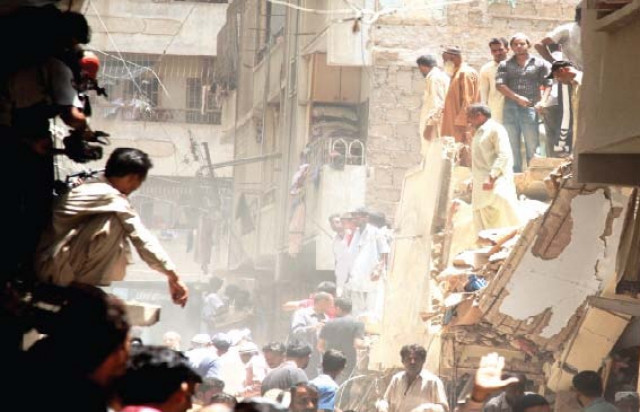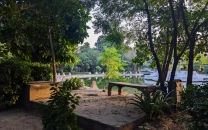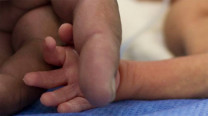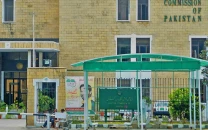Rescue work continues: Building made at Partition decides to finally give in
Obstructed sewage pooled around the foundation, leaving at least 5 people dead.

Rescue work continues: Building made at Partition decides to finally give in
A rexine handbag. An ersatz gilt jewellery box. A stuffed red rabbit. Before the five-storey Qasr-e-Rukaiyya building in Lyari came crashing down, these items belonged in someone’s house. Now, at least five people are dead, including a year-old baby. Twenty others are injured and at least 30 people are trapped in the rubble.
The building was constructed before Partition on Plot No. LY-10/65, according to information collected from sources in the District Municipal Corporation South. Initially, it was two stories but the residents had constructed another three floors.
A breakdown in the sewage system was to blame, said the preliminary report by the Sindh Building Control Authority’s Controller of Building Structures Shafiq and area controller Aqeel Abidi. The SBCA’s director general Manzoor Qadir explained that the obstruction in the system caused sewage to accumulate around the foundation, weakening the pillars. They simply gave up and the building came down.
In the morning, chaos dominated the narrow Moosa Lane No. 6 near the Kausar Mosque. Stretchers and bodyboards were held above the bobbing heads, as rescue workers battered their way through. Someone used a nearby mosque’s loudspeaker to ask people to make way, let the tractor in.
Clouds of dust sieved down through the air, covering prayer caps, bare heads, dupattas, mixing with tears. One weeping woman was led away and prevented from moving closer to the collapsed building.
“At 9 am we could feel the building shaking,” said Rasheeda, who lived in Qasr-e-Rukaiyya with her seven children. “We told our landlord but he didn’t really care. We left and then a few hours later, the building collapsed.”
Qasr-e-Rukaiyya was divided into two blocks, and while one building had collapsed, a “four-inch gap” had emerged in the other’s side, said a resident assisting with the rescue. The occupants of that building were evacuated, but others kept wandering in, only to be yelled at. “That building will collapse… move away!”
It may have collapsed before them, but residents were clueless as to why and how the building disintegrated. “These buildings have been here since I was a child, and I’m now 40,” said a woman, peering at the men standing on top of what was left of Qasr-e-Rukaiyya.
“All the buildings here have these problems but landlords don’t care,” said another woman, who was taking in the number of TV crews at the scene. “They are only looking out for their own interests.”
Abdul Sattar Edhi, a veteran of dozens of disasters, sat quietly outside an apartment building, taking in the scene. As reporters filed dispatches, camerapersons found concrete structures to stand on and film from. Others flattened against the walls of other buildings as the vehicles drove in. In the surrounding lanes, life went on, as people bought vegetables and fruit from carts.
Volunteers linked arms to make a gate of sorts for people to enter and exit in a controlled manner. The lane was partitioned mid-way with ropes, lifted only for journalists and rescue workers. They tried to stop passersby, who kept pouring in to gawk, following the time-honoured tradition of amassing at disaster sites in Karachi. Others peered out of windows of neighbouring buildings.
Rescue workers - from Edhi, Aman Foundation and Chhipa - had covered the area, while the police tried to control the crowds, often in vain. Deputy Commissioner South Jamal Mustafa Qazi told The Express Tribune that international experts have been hired to recover the people trapped inside.
One cameraperson nearly came to blows with a volunteer, and several women were shouted at by men from the family to get into the house and not endanger their lives. “What the hell are you doing here?” screamed one dust-covered volunteer to several men watching the rescue crews work. “Please leave.”
For those trapped under the rubble, they had no chance of being heard over the crunching tyres of the tractor, wailing ambulances and shouts. At one point, volunteers asked for silence, to stop the screaming and chatter, so they could hear each other.
The twisted vanes of a fan peeked out from the debris as rescue workers lifted rubble and tossed it out on to the lane for it to be cleared away. A teddy bear lay to a side and was trampled on before being scooped away with piles of concrete. Its owner - dead, missing, injured or a survivor - will be forgotten tomorrow as yet another victim of the myriad building collapses in Karachi.
Published in The Express Tribune, August 5th, 2011.
You can view a slideshow of pictures from the location here.



















COMMENTS
Comments are moderated and generally will be posted if they are on-topic and not abusive.
For more information, please see our Comments FAQ